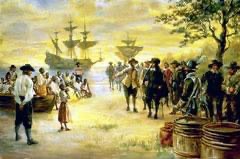In the beginning.

English trading in enslaved Africans became established in the 1500’s. In 1562, Captain John Hawkins was the first known Englishman to include enslaved Africans in his cargo. Queen Elizabeth I of England approved of his journey, during which he captured 400 Africans.

Knighted, Arms were granted to John Hawkins in 1565 for the massive profits he made in the slave trade, following his second successful expedition to transport slaves from West Africa to the Americas.
The crest of the coat of arms featured a Black man bound and captive with annulets in his arms and ears .
On March 24, 1603, James inherited the throne of England when Queen Elizabeth I of England died.
On April 10, 1606, King James I of England granted a charter to the investors of the London Virginia Venture. Captain John Smith wrote that Wingfield was one of the early and prime movers and organizers in 1602-1603 in showing great change and industry in getting the Virginia Venture moving. Wingfield was one of the four incorporators for the London Virginia Company in the Virginia Charter of 1606 and one of its biggest financial backers. He recruited his cousin, Captain Barthowlomew Gosnold of the Godspeed ship, and about 40 of the 105 would be colonists.
Captain Edward-Maria Wingfield was the only shareholder to set sail. Such a venture allowed the Crown to reap the benefits of colonization–natural resources, new markets for English goods, leverage against the Spanish-without bearing the costs. Meanwhile, investors were protected from catastrophic losses in the event of the project’s failure.
On December 20, 1606, three ships left England. The original Susan Constant, Godspeed and Discovery set sail from London and headed to the New World (Virginia) to start a new colony. The settlers arrived in the Chesapeake Bay of Virginia on April 26, 1607. It permitted them to settle a swath of the North American coast and led to the establishment of a colony. The three ships stopped at present day Virginia Beach, spent two weeks at the Kecoughtan Indian Village in present day Hampton, Virginia, before establishing a settlement.
On May 12, 1607, Wingfield designated a site approximately fifty miles upriver as the focus of the settlement and named it Jamestown in honor of King James I of England. The following day. Edward -Maria Wingfield was elected by his peers and councilors as their president of the governing council for one year, beginning May 13, 1607, of what became the first successful democratic election held in the English speaking colony of the New World in Jamestown, Virginia. Virginia celebrated its 400th Anniversary of the founding of Jamestown in 2007.
In 2008, the United Nations Department of Public Information initiated an effort to reach out to schools and other educational institutions, civil society, media and the general public by holding a solemn ceremony in the United Nations General Assembly Hall and had an exhibition, “The Middle Passage: White Ships, Black Cargo” in the visitor’s lobby. UNESCO in New York also held a briefing titled, “Lest WE Forget: Breaking the Silence on the Transatlantic Slave Trade,” which was proceeded by the documentary, “The Slave Route: A Global Vision.” Their goal was to tell the true story of the transatlantic slave trade.
Venita joined the efforts of the United Nations to educate people about the on-going initiatives to stomp out modern day slavery, human trafficking, racism, discrimination and to commemorate the International Day of Remembrance of the Victims of Slavery and the Transatlantic Slave Trade where the first seeds of slavery were sown in Hampton, Virginia.
“To know this story is to know you hear the ancestral voices speaking to you. A legacy is critical to the future.” - Venita Benitez
In 2008, Venita shared her vision with Calvin Pearson, Founder of Project 1619, Inc. whose mission was to promote the true story of the first enslaved Africans in Virginia in 1619. They collaborated with civic leaders in Hampton, Virginia to commemorate the remembrance of the victims the following year.
In 2009, Venita and Calvin co-produced the International Day of Remembrance of the Victims of Slavery and the Transatlantic Slave Trade in Hampton, Virginia, where slavery began, instead of New York City.
About the Author:
Venita Maria Benitez was raised knowing that she was a direct descendant of Sir Richard Wingfield M.P.,his son Sir John Wingfield, Knight of the Bath and Robert Gosnold III (uncle to Captain Bartholomew Gosnold.)
In 2005, she started a journey to research her ancestors in England. After making a successful genealogy contact with the Wingfield family, she was invited to attend England’s 400th Anniversary for the King James Charter, commemorating 400 years since the signing of England granting the charter to the investors of the London Virginia Venture.
The spiritual experiences Venita felt in England led her to share her ancestral knowledge and help prepare America for a historic awakening on the history of the first Enslaved Africans taken to Point Comfort in 1619.
Venita Benitez
National Advisory Board Member, Project 1619 Inc.

















Comments